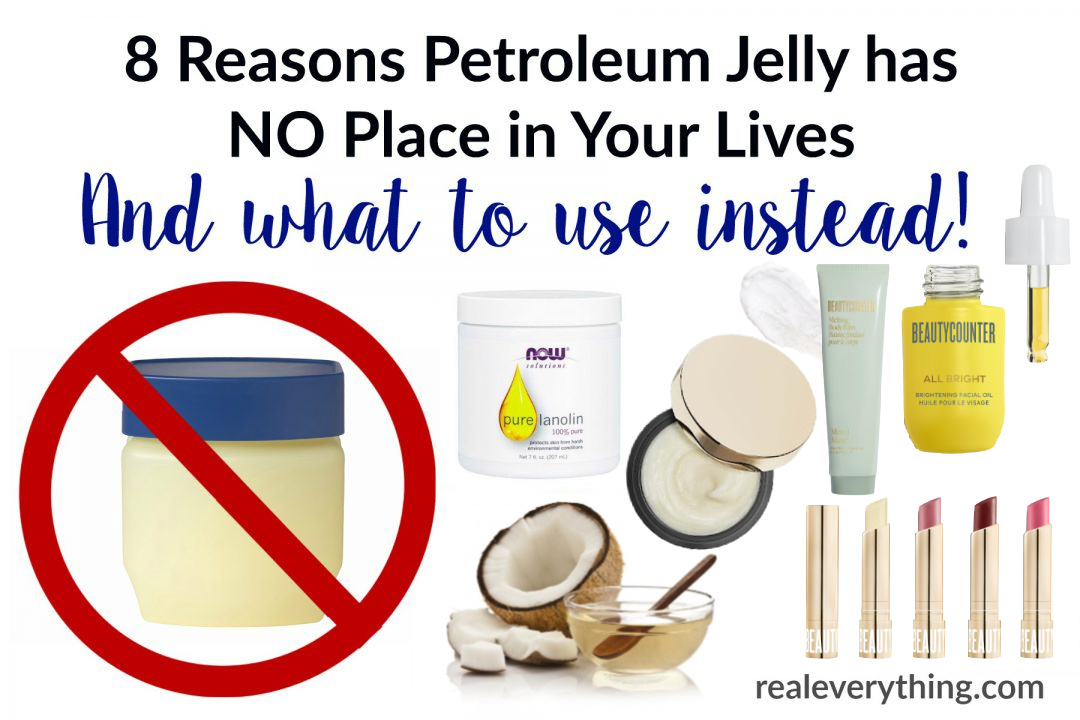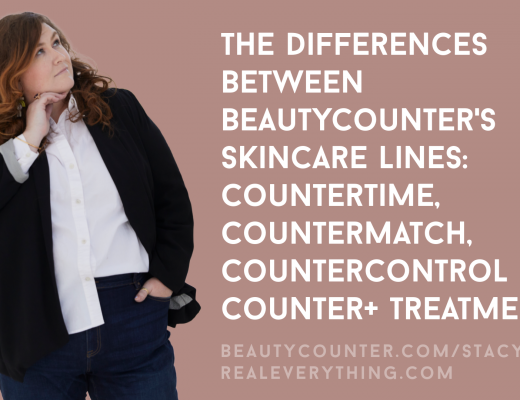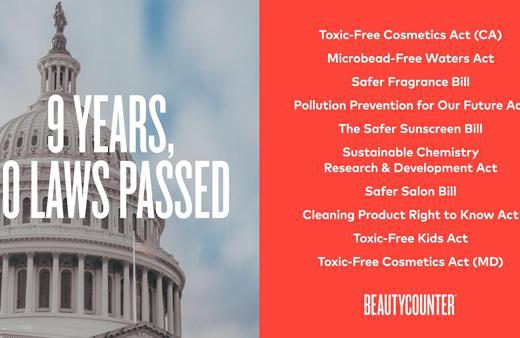Did you know our skin changes from season to season? In the winter many of us experience flares from dry skin conditions, such as eczema, milia, dermatitis, psoriasis, KP (keratosis pilaris), rosacea, dandruff, lupus flares or even simply drier than normal skin. There are multiple reasons winter can cause flares. We’re gonna run thru them all today diving into the science of skin and supporting the skin barrier for dry winter skin:
- Less sun: Vitamin D absorption thru sunlight is essential for skin and overall health. Ever notice how you’re always glowing after a day at the beach?!
- Less optimal nutrition: from Halloween to New Years many of us consume more sugar than usual. This can change our gut’s microbiome, hormones, and trigger inflammation.
- It’s dry and cold! This can cause your skin’s own protective system to break down.
I wanted to take a deep dive into the issues many of us face from the dry, cold winter. If you ever have any questions, don’t hesitate to contact me or comment below, because I guarantee you’re not the only one! If you want to learn even more, I have a great podcast that goes into detail on the science of winter skin!
The Science of Dry Winter Skin
Our skin’s epidermis is made up of 5 layers with stratum corneum, the moisture barrier, as the outermost layer. In and of itself it consists about 20 layers of specialized skin cells and keratin that are continuously renewing and exist to protect your insides. Eyelids are thinner, while layers such as your hands and heels are thicker.
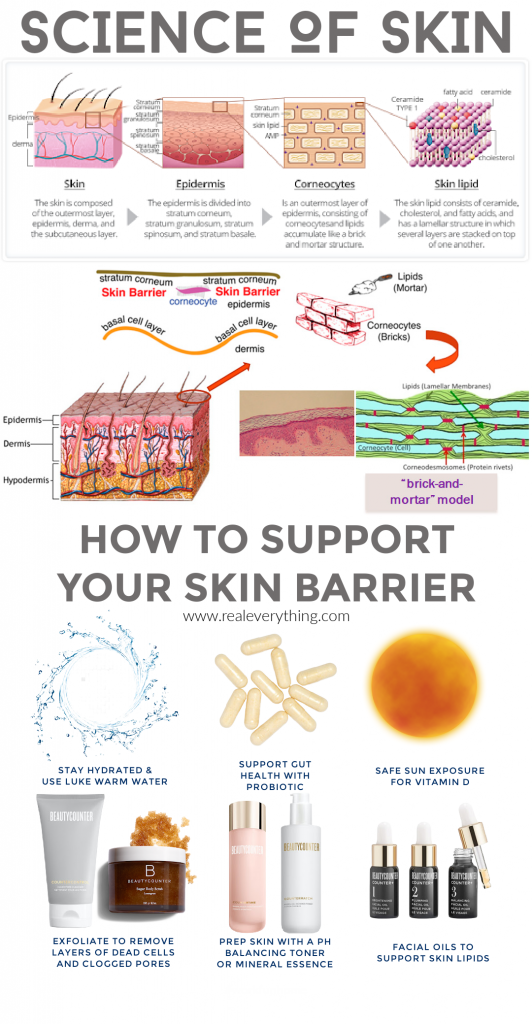
Think of your skin like bricks and mortar: the bricks are mostly made up of keratin, a protein also found in hair and nails. The mortar is made out of lipids that float into the space between the bricks as protection. ✨ Together it forms the skin’s protective barrier.
The stratum corneum is slightly acidic with a pH of ~ 4-5.5 (aka the acid mantle). This helps form an effective, waterproof barrier to the outside world, preventing epidermal water loss (drying out) and pathogens like bacteria and toxins in.
Water is your friend
Okay – one of the easiest changes you can make: water!! Both to stay hydrated to help dry winter skin and the temp you use to wash. Hot water can be overly drying for those with a damaged skin barrier.
As a rule of thumb, it’s best to use luke-warm water (not much hotter than our body temp). This allows us to get clean without over drying or stripping too many of your skin’s natural oils which are essential to protecting you – inside & out. Seriously!
Our skin acts as a barrier to the outside world – but it is not impenetrable! Protecting the moisture barrier (or the lipid barrier… or the acid mantle) is THE MOST IMPORTANT step in skincare, it truly is the key to healthy skin.
Just four simple steps, no really!
Our skin NEEDS a 4 step process: wash (exfoliate), prep (tone pH), then treat and protect the moisture barrier with lipids. Are you currently doing all of those?
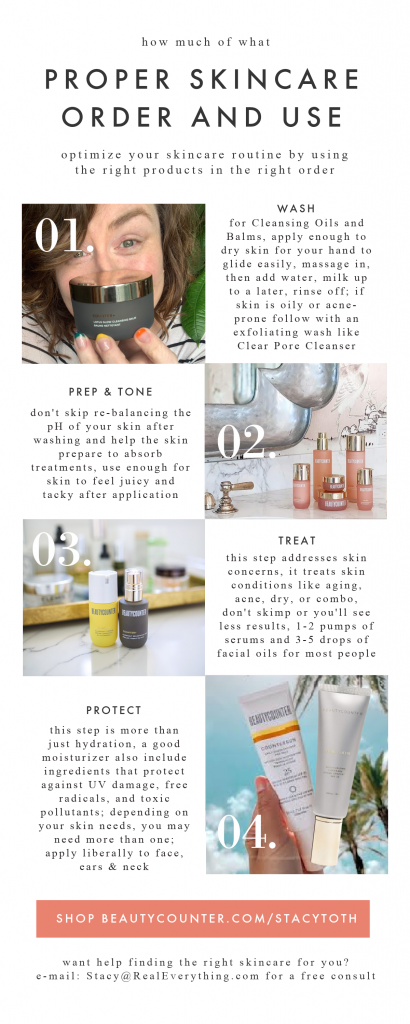 Most of us are not doing all 4 steps on face and body, you’re not alone! But, if your skin is experiencing issues it is almost always because the layers of your skin are disrupted – so focus on helping your epidermis shed with exfoliation, then rebalancing the pH of the acid mantle, and protecting with lipids is the routine we all need. This applies to dryness on the body too. For example, I have a 4 step routine for under my arms because my skin is sensitive to the pH disruption of natural deodorants. What products you use is dependent on your skin’s specific needs. I’m happy to help curate a routine that’s right for you or a loved one.
Most of us are not doing all 4 steps on face and body, you’re not alone! But, if your skin is experiencing issues it is almost always because the layers of your skin are disrupted – so focus on helping your epidermis shed with exfoliation, then rebalancing the pH of the acid mantle, and protecting with lipids is the routine we all need. This applies to dryness on the body too. For example, I have a 4 step routine for under my arms because my skin is sensitive to the pH disruption of natural deodorants. What products you use is dependent on your skin’s specific needs. I’m happy to help curate a routine that’s right for you or a loved one.
Exfoliation is for everyone!
Following up on exfoliation: it is really important no matter your skin type! If your makeup cakes, flakes, or doesn’t sit well, if you have dry, combo, or oily skin, if you have milia, rosacea… you need to exfoliate. It removes the dead skin cells that clog pores, improves circulation, encourages cell turnover & better absorption of skincare.
Help those new cells forming when you sleep, remove the dry, dead skin with either a physical (I love the Clear Pore Cleanser because the jojoba beads are most like your own sebum and very gentle) and/or chemical (like fruit acids in Overnight Resurfacing Peel) to help gently slough. Both can be used together, depending on your skin. For your body try the Sugarbuff Body Polish (especially great because it has good lipids as the base) and the incredible new Solemates Exfoliating Duo (works anywhere on the body).
I personally double cleanse to get the benefits of both: I wash with a lipid to hydrate first and remove makeup most effectively with our Countertime Cleansing Oil and then I clear out the pores with exfoliating wash. Not everyone needs to do this, but it could be a game changer for you!
Balancing the pH
We covered why toning the skin is critical for the pH of the acid mantle. But, it is the most commonly skipped step. *tsk tsk* Let me tell you why it’s my favorite! Prep balances acidity, allowing your skin flora to thrive, sweeps impurities away, helps better absorb your skincare, can even skin tone, reduce pore size, etc.
Think about it this way: Your skin is like a sponge. Cream on a brittle dry sponge won’t absorb. But if you wet the sponge, the cream will sink in. Similarly, large pores are commonly a dry skin issue, like dry earth with cracks. Reducing moisture exacerbates it, but proper levels let good in and keep bad out, with no cracks or divots.
Which brings me to steps 3 & 4: treat your skin’s needs (anti-aging serum for example) then protect it with hydrating moisturizer (ideally with SPF). We say “protect” because the stratum corneum, the moisture barrier, when intact properly prevents pathogens in or moisture out. And thus concludes my ted talk on why skin regimens are 4 steps 😉
Sunscreen? YES even in Winter
Now remember I mentioned Vitamin D being a reason our skin acts up in the winter?So, yes – you need sunlight, but don’t want sun damage (what causes 80-90% of the signs of aging). You also want to make sure you’re well moisturized before heading out into cold, dry wind!
I love our mineral-based sunscreen which contains Zinc and is anti-inflammatory. Dew Skin + facial oil (combined as one step) is my moisturizer and the secret to truly dewy, glowing skin. Yep, I have oily skin but add oil (details next!). If you don’t want any color, I recommend our Countersun Daily Sheer Defense. They both protect from the sun and from damaging blue rays of screens!
Oils are your secret weapon, even for oily skin
I’m going to let you in on a little secret… facial oils is the secret to my skin aging like a fine wine.
The good: as I mentioned above, our skin NEEDS lipids. They’re a big ol’ drink for your skin. Our skin naturally produces oil (sebum), but as we age or have inflammation our oil and collagen production can decrease – which causes dry skin symptoms. Lack of oil in the skin can lead to dry patches/flaky skin, fine lines, wrinkles, and breakouts (yes, acne from being too dry). The right oils also help to tackle specific skin concerns (reduce your own oil production, fight breakouts, plump from lost hydration, brighten and reduce redness or irritation. They really do work with every skin type!
The bad: the wrong type of oils on the wrong person can be occlusive. For example, coconut oil doesn’t add nutrient value to the skin and is pore clogging.
We have 3 types of facial oils. Plus, cleansing balm (swiss army knife of skincare), cleansing oil, body balms and oil. Have you ever tried any?
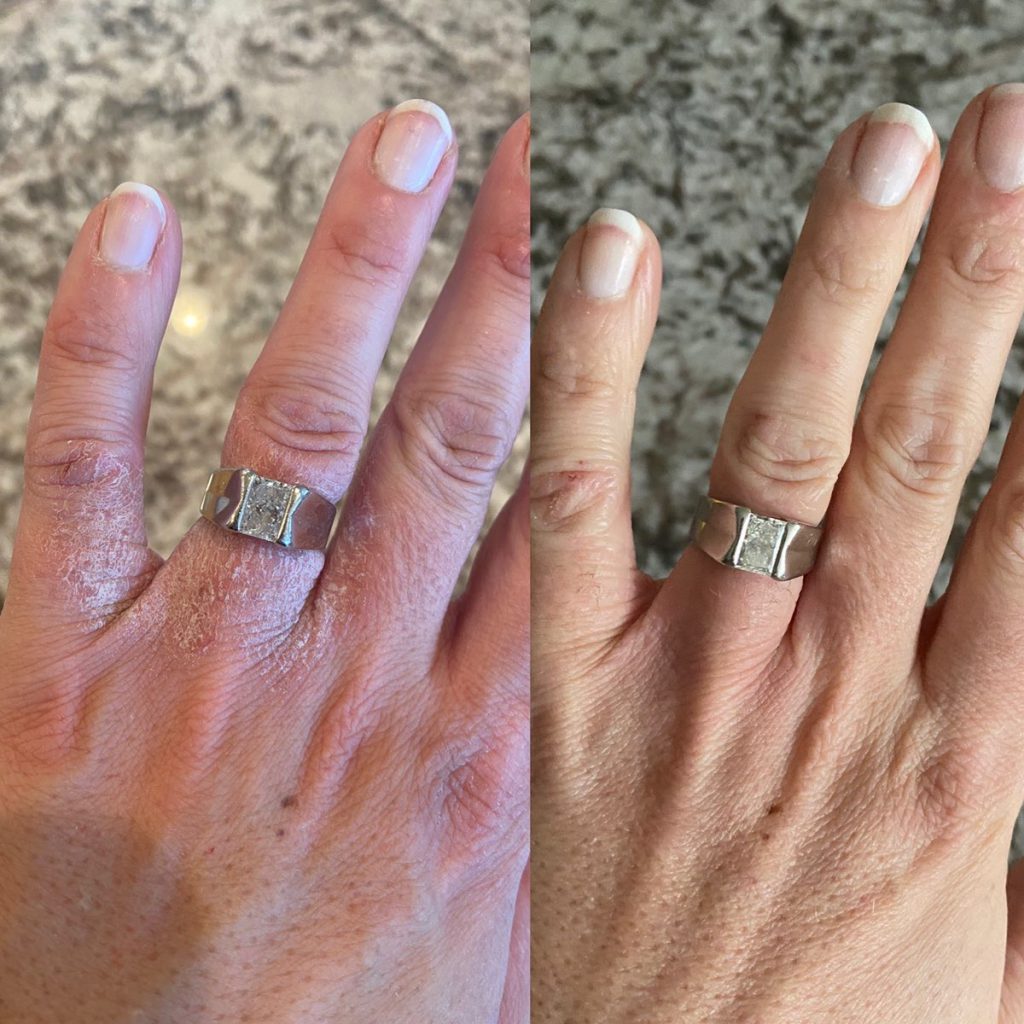
IT WORKS! These are the hands of a team member who helped me prep this info, read the to-do actions, did them, and got this result in THREE days!
Petroleum is bad all around
Another example of what not to use: petroleum. Not only is it a bi-product of crude oil with links to cancer and hormone disruption, but it isn’t ideal as a skincare product. On dry skin can feel good at first, but the moisture lock means nothing can get in or out and our skin needs to breath and be moisturized to heal. Anyone else ever notice your skin becomes even more chapped overtime when using petroleum based lip products?
I avoid petroleum jelly based chapsticks/balms and opt for our Jellies (which just launched full time into the line today!!) during the day and lip conditioner at night, the calendula is so healing for your lips. I recommend applying your lip conditioner before bed as part of your evening skincare routine!
Remember exfoliation? Lip scrubs are great for dry flaky winter lips! Always condition immediately after the scrub.
Want more science on this?
Checkout 8 Reasons Petroleum Jelly has No Place in Your Lives!
So what DO we love for dry winter skin?
Some of our Dry Winter Skin Beautycounter favorites:
- Lotus Glow Cleansing Balm (ideal for those with eczema or dry skin patches)
- Overnight Resurfacing Peel
- Sugarbuff Body Polish in Lemongrass
- Countertime line
- All Bright Brightening Facial Oil
- Melting Body Balm
- Superquench Body Butter
- Luminous Hydration Body Oil
- Clear Pore Cleanser
- Dew Skin
- Countersun Sheer Defense
- Reflect Effect AHS Smoothing Mask
- Balm for All
- Softening Hand Lotion in Neroli
- NEW Clean Swipe Hyaluronic Lip Balms
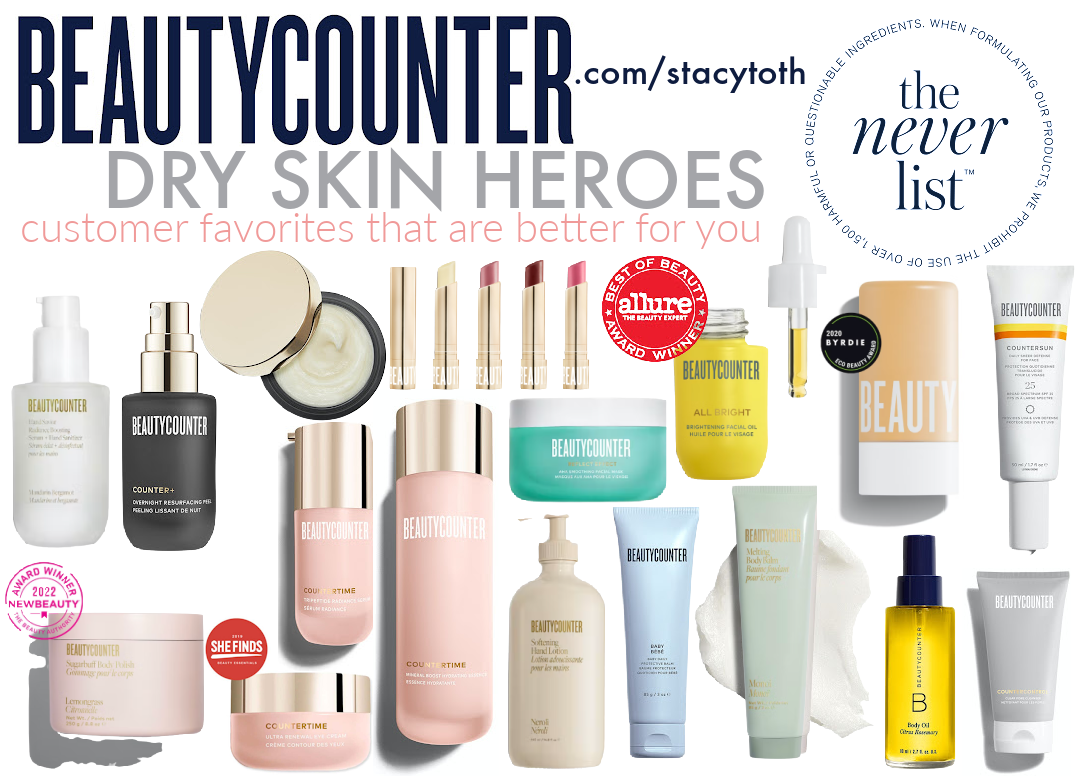
I’d love to help you figure out what’s right for you! I offer free consults, just e-mail Stacy@RealEverything.com.
Ready to shop? Choose Stacy Toth HERE so I can send a thank you!
Never want to miss a post, sale, or deal? Join my Healthy Inside & Out e-mail list for more info on non-toxic living and safer skincare!
Want more info on our Real Life? Healthy recipes, parenting tips, and general lifestyle stuff goes out in our Real Everything newsletter, join here.
Note: Stacy is not a medical professional. This article is for general educational purposes and NOT intended to diagnose, advise, or treat any physical or mental illness. We always recommend you consult a licensed service provider.

